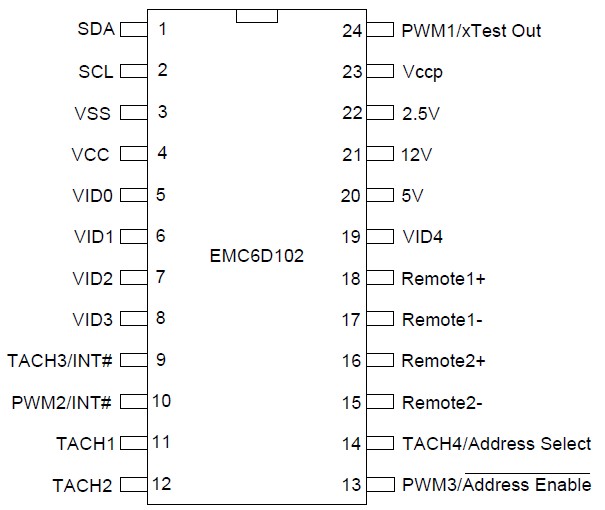Features: `3.3 Volt Operation (5 Volt Tolerant Input Buffers)
`SMBus 2.0 compliant interface (Fixed, Not Discoverable) With Three Slave Address Options
`Fan Control
- PWM (Pulse width Modulation) Outputs (3)
- Fan Tachometer Inputs (4)
- Individual status and enable bits per tach input
- Programmable automatic fan control based on temperature
- Fan ramp rate control for acoustic noise reduction
`Temperature Monitor
- Monitoring of Two Remote Thermal Diodes (+/- 3 deg C accuracy)
- Internal Ambient Temperature Measurement
- Limit Comparison of all Monitored Values
- Individual status and enable bits per thermal input
- Interrupt Pin for out-of-limit Temperature Indication
- Configurable offset for internal or external temperature channels.
- Supports 4 programmable temperature averaging modes
- 2 monitoring modes: Continuous or Cycle (Power Saving mode)
- Offers 2 Low Power Modes when monitoring is off: Sleep and Shutdown
`Voltage Monitor
- Monitor Power supplies (+2.5V, +5V, +12V, Vccp, and VCC)
- Individual status and enable bits per voltage input
- Limit Comparison of all Monitored Values
- Interrupt Pin for out-of-limit Voltage Indication
- Supports 4 programmable voltage averaging modes
- 2 monitoring modes: Continuous or Cycle (Power Saving mode)
- Offers 2 Low Power Modes when monitoring is off: Sleep and Shutdown
`5 VID (Voltage Identification) inputs
`XOR Tree test mode
`Mechanical Package (24-pin SSOP; green, lead-free)Pinout Specifications
SpecificationsOperating Temperature Range 0 to +70
Storage Temperature Range -55° to +150
Lead Temperature Range Refer to JEDEC Spec. J-STD-020
Maximum Vcc +5.5V
Positive Voltage on any pin (except for analog inputs), with respect to Ground Vcc+0.3V
Negative Voltage on any pin (except for analog inputs), with respect to Ground -0.3V
Note: Stresses above those listed could cause permanent damage to the device. This is a stress rating only and functional operation of the device at any other condition above those indicated in the operation sections of this specification is not implied. When powering this device from laboratory or system power supplies, it is important that the Absolute Maximum Ratings not be exceeded or device failure can result. Some power supplies exhibit voltage spikes on their outputs when the AC power is switched on or off. In addition, voltage transients on the AC power line may appear on the DC output. If this possibility exists, it is suggested that a clamp circuit be used.
DescriptionThe EMC6D102 is an environmental monitoring device with automatic fan control capability. This ACPI compliant device provides hardware monitoring for up to five voltages and three thermal zones, measures the speed of up to four fans, and controls the speed of multiple DC fans using Pulse Width Modulator (PWM) outputs.
The EMC6D102 hardware monitor provides analog inputs for monitoring external voltages of +2.5V, +5V, +12V and Vccp. This device has the capability to monitor its own internal VCC power supply, which may be connected to either main power (VCC) or the suspend power well (VTR). In addition to monitoring the processor voltage, VID inputs are available to identify the voltage specification. External components are not required for voltage scaling or similar treatment.
The EMC6D102 hardware monitor includes support for monitoring three thermal zones: two external and one internal. The external temperatures are measured via thermal diode inputs capable of monitoring remote devices. In addition, they are equipped with an ambient temperature sensor for measuring the internal temperature.
EMC6D102 Pulse Width Modulators (PWM) control the speed of the fans by varying the output duty cycle of the PWM. Each PWM can be associated with any or all of the thermal zones monitored. As the temperature of the associated zone varies, the PWM duty cycle is adjusted accordingly. The Ramp Rate Control feature controls the rate of change of the PWM output, thereby reducing system noise created by changing the fan speed. The speed of each fan is monitored by a Fan Tachometer input. The measured values are compared to values stored in Limit Registers to detect if a fan has stalled or seized.
Fan speed may be under host software control or automatic. In host control mode, the EMC6D102 host software continuously monitors temperature and fan speed registers, makes decisions as to desired fan speed and sets the PWM's to drive the required fan speed. This device offers an interrupt output signal (INT#), which may be used to interrupt the host on out-of-limit temperature or voltage condition enabling an ACPI response as opposed to the host software continuously monitoring status. In auto "zone" mode, the logic continuously monitors the temperature and fan speeds and adjusts speeds without intervention from the host CPU. Fan speed is adjusted according to an algorithm using the temperature measured in the selected zone, the high and low limits set by the user, and the current fan speed.

 EMC6D102 Data Sheet
EMC6D102 Data Sheet







